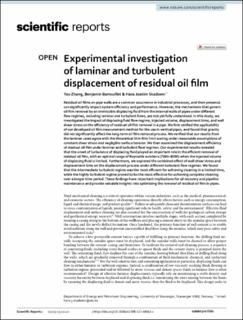| dc.contributor.author | Zhang, Yaozhi | |
| dc.contributor.author | Barrouillet, Benjamin | |
| dc.contributor.author | Skadsem, Hans Joakim | |
| dc.date.accessioned | 2023-12-01T13:21:20Z | |
| dc.date.available | 2023-12-01T13:21:20Z | |
| dc.date.created | 2023-11-30T14:31:33Z | |
| dc.date.issued | 2023-11 | |
| dc.identifier.citation | Zhang, Y., Barrouillet, B., Skadsem, H. (2023) Experimental investigation of laminar and turbulent displacement of residual oil film. Scientific Reports, 13, 21120 (2023) | en_US |
| dc.identifier.issn | 2045-2322 | |
| dc.identifier.uri | https://hdl.handle.net/11250/3105626 | |
| dc.description.abstract | Residual oil films on pipe walls are a common occurrence in industrial processes, and their presence can significantly impact system efficiency and performance. However, the mechanisms that govern oil film removal by an immiscible displacing fluid from the internal walls of pipes under different flow regimes, including laminar and turbulent flows, are not yet fully understood. In this study, we investigated the impact of displacing fluid flow regime, injected volume, displacement time, and wall shear stress on the efficiency of residual oil film removal in a pipe. We first verified the applicability of our developed oil film measurement method for the use in vertical pipes, and found that gravity did not significantly affect the long-term oil film removal process. We verified that our results from the laminar cases agree with the theoretical thin-film limit scaling under reasonable assumptions of constant shear stress and negligible surface tension. We then examined the displacement efficiency of residual oil film under laminar and turbulent flow regimes. Our experimental results revealed that the onset of turbulence of displacing fluid played an important role in the efficient removal of residual oil film, with an optimal range of Reynolds numbers (7000–8000) when the injected volume of displacing fluid is limited. Furthermore, we explored the combined effect of wall shear stress and displacement time on the displacement process under different turbulent flow regimes. We found that the intermediate turbulent regime was the most efficient for achieving cleaning in a limited time, while the highly turbulent regime proved to be the most effective for achieving complete cleaning over a longer time period. These findings have important implications for oil recovery and pipeline maintenance and provide valuable insights into optimizing the removal of residual oil film in pipes. | en_US |
| dc.language.iso | eng | en_US |
| dc.publisher | Springer Nature Switzerland AG | en_US |
| dc.rights | Navngivelse 4.0 Internasjonal | * |
| dc.rights.uri | http://creativecommons.org/licenses/by/4.0/deed.no | * |
| dc.title | Experimental investigation of laminar and turbulent displacement of residual oil film | en_US |
| dc.type | Peer reviewed | en_US |
| dc.type | Journal article | en_US |
| dc.description.version | publishedVersion | en_US |
| dc.rights.holder | © 2023 The Author(s). | en_US |
| dc.subject.nsi | VDP::Teknologi: 500 | en_US |
| dc.source.volume | 13 | en_US |
| dc.source.journal | Scientific Reports | en_US |
| dc.identifier.doi | 10.1038/s41598-023-48563-x | |
| dc.identifier.cristin | 2206602 | |
| dc.source.articlenumber | 21120 (2023) | en_US |
| cristin.ispublished | true | |
| cristin.fulltext | original | |
| cristin.qualitycode | 1 | |

